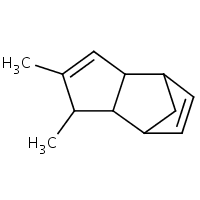Methylcyclopentadiene dimer
Agent Name
Methylcyclopentadiene dimer
CAS Number
26472-00-4
Formula
C12-H16
Major Category
Other Classes

Synonyms
3a,4,7,7a-Tetrahydrodimethyl-4,7-methano-1H-indene; 3a,4,7,7a-Tetrahydrodimethyl-4,7-methanoindene; Bis(methylcyclopentadiene); Dimethyldicyclopentadiene; 4,7-Methano-1H-indene, 3a,4,7,7a-tetrahydrodimethyl-; 4,7-Methanoindene, 3a,4,7,7a-tetrahydrodimethyl-; [ChemIDplus] MCPD Dimer; [EPA ChAMP: Hazard Characterization] 2,5-Dimethyl-3a,4,7,7a-tetrahydro-1H-4,7-methanoindene; [ECHA REACH Registrations] MCDP; [ExxonMobil MSDS] UN3295
Category
Aliphatics, Unsaturated
Description
Colorless liquid; [CAMEO] Pale yellow liquid with a hydrocarbon odor; [ExxonMobil MSDS]
Sources/Uses
Used to make fine chemicals; [ExPub: ECHA REACH Registrations] Used as a chemical feedstock; [ExxonMobil MSDS]
Comments
May auto-oxidize on exposure to air forming explosive peroxides; [CAMEO] Liquid causes smarting of skin and first degree burns on short exposure; May cause second degree skin burns from longer exposure; Vapor or mist causes eye, mucous membrane, and upper respiratory tract irritation; Inhalation may cause dizziness, difficulty breathing, and loss of consciousness; [CHRIS] Effects to the kidney (increased hyaline droplets in all treated males) and liver (hepatocellular hypertrophy with increased liver weights in females at 100 mg/kg/day and males at 300 mg/kg/day) observed in 28-day oral study of rats; Gross and histopathological changes of the liver and kidney observed in 9-day inhalation study of rats; No reproductive toxicity observed in rats; Developmental toxicity (lower pup birth weight and weight gain) seen in the presence of maternal toxicity in rats; Evidence of neurotoxicity in rats; [EPA ChAMP: Hazard Characterization]
Contains 0-0.5% benzene (CAS# 71-43-2) and 0-3.5% dicyclopentadiene (CAS# 77-73-6); A skin and eye irritant; An aspiration hazard by ingestion (may cause lung injury); Harmful by inhalation; [ExxonMobil MSDS] See "Dicyclopentadiene."
Contains 0-0.5% benzene (CAS# 71-43-2) and 0-3.5% dicyclopentadiene (CAS# 77-73-6); A skin and eye irritant; An aspiration hazard by ingestion (may cause lung injury); Harmful by inhalation; [ExxonMobil MSDS] See "Dicyclopentadiene."
Biomedical References
Exposure Assessment
Vapor Pressure
14.2 mm Hg
Lethal Concentration
LC50 (rat) > 3,240 mg/m3/4hr
Explanatory Notes
The Guide in the Emergency Response Guidebook is for "Hydrocarbons, liquid, n.o.s."
Adverse Effects
Neurotoxin
Acute solvent syndrome
Hepatotoxin
Hepatoxic (a) from occupational exposure (secondary effect) or (b) in animal studies or in humans after ingestion
Nephrotoxin
Yes
Dermatotoxin
Skin burns
Diseases, Processes, and Activities Linked to This Agent
Diseases
Occupational diseases associated with exposure to this agent: